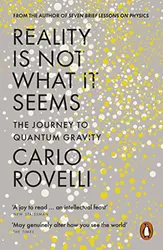As the subtitle suggests, in this book Carlo Rovelli takes us on a journey through the study of gravity from antiquity to the latest cutting edge theories about its true nature (as of 2014 when the original Italian version of this book was published). The author is clear to state that the theory of quantum gravity described in the book is only a possible, tentative theory and that it’s his opinion that this is a promising model and not established scientific fact. On the journey, we learn about Democritus (and other ancient Greeks), Gallileo, Newton, Einstein and the quantum theorists including Neils Bohr and Paul Dirac.
I think this book brilliantly explains how our understanding of the nature of reality has changed over time. There is a diagram repeated and extended throughout the book which summarises our understanding of what the universe is made of, as it changes with each revolution in physics, from “Space”, “Time” and “Particles” in Newton’s time, to “Covariant quantum fields” in the theory presented towards the end of the book.
Physics at this level is really described by equations. There are a few equations in this book, but these are only included for completeness and they aren’t the real point of the book. You’re not expected to understand them in order to read on. But this book performs the magic trick of making you feel like you understand the physics as you read. It conveys the sense of how uninituitive the universe is when you get beyond the classical physics that Newton defined.
There were some concepts in this book that I’ve read about elsewhere and never really got a good grasp on, but the explanations in this book helped a lot. I’ve always struggled with the concept of general relativity describing spacetime being curved (or for that matter, what “spacetime” really is), but this book gave me a more intuitive idea of what that means. How we can live in a universe that is finite but has no edges is also explained really well. I’m still trying to get my head around the idea that the gravititational field is space though!
There are some interesting artistic and cultural parallels that the author brings in, as creative minds have explored the nature of reality through literature. In some cases, they’ve got surprisingly close to what we now think are the right answers, such as a description of the universe by Dante that sounds very close to the “3-sphere” that allows our universe to be finite but without an edge.
The later parts of the book describe the theory of quantum gravity that the author’s own research has been focused on. In general, physics gets weirder and less intuitive the further you get into this book. Things that seem solid and reliable turn out to not really exist. Only the relations between things exist at the moment they interact and don’t really exist independently at other times. Time itself doesn’t really exist and is just an averaging of lots of events seen from our perspective, in the same way that heat is just the averaging of the movement of lots of molecules in a substance; a single molecule can’t be said to be “hot” on its own. Space itself doesn’t exist, at least not as a place in which other events happen. I’m not sure if the human brain is really capable of grasping what this all actually means. To me, it seems like the further we go into this type of physics, the more things seem like pure information and not actual things that exist. The type of physics described at the end of this book, with its “spinfoams” of how quantum space changes, seems to be more about a set of rules than about anything real. But what’s defining those rules and why are they the way they are?
I enjoy having my concept of reality challenged in this way, and this book was a very enjoyable, mind-bending read for me. It reminded me of how weird the universe is, and that the more we know, the more we realise we don’t understand.
